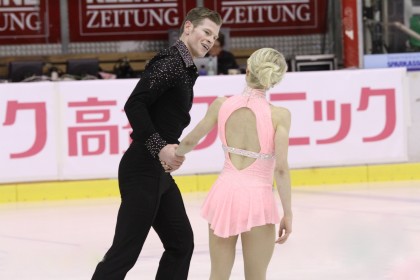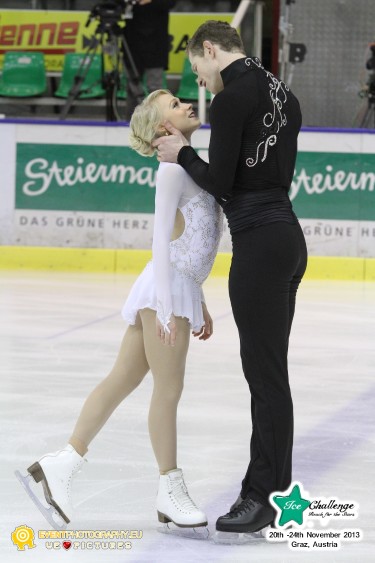by Jacquelyn Thayer
Though they skate this week for British national gold, North America has proven a home for Caitlin Yankowskas and Hamish Gaman.
After the American Yankowskas and British Gaman kicked off their international partnership at the dance-centered Arctic Edge in Canton in 2013, the two relocated in April 2014 to the more freestyle-oriented Skating Club of Boston. This summer, the couple set northward to make a new home at Montreal’s Patinage Saint-Leonard, where pairs including Meagan Duhamel and Eric Radford, Marissa Castelli and Mervin Tran and Natasha Purich and Drew Wolfe train. The two worked with coaches Bruno Marcotte and Richard Gauthier for about nine days in June before officially relocating in July.
“There’s such a good energy and they’re fantastic coaches, and obviously working with some more pairs skaters, and obviously Eric and Meagan, is just wonderful,” said Yankowskas.
“There’s a big contrast in Richard and Bruno,” said Gaman. “You get sort of two different perspectives–more of an old-school coaching method from Richard and you get more new-school from Bruno, so as a combination it’s fantastic. You get the best of both worlds.”

Yankowskas and Gaman during the short program at 2013 Ice Challenge. Photo courtesy yankowskasgaman.com.
The local presence of choreographer Julie Marcotte is an additional perk.
“It’s similar to Canton because we have our coaches and our choreographer all in the same city,” said Yankowskas. “And obviously Marina choreographs and she’s at the rink, and that was always a bonus there. It’s refreshing to have that here in Montreal, too.”
While Boston was familiar territory for native New Englander Yankowskas, Montreal has offered a little familiarity for Gaman–though not without challenge.
“The biggest thing has been just the language barrier,” said Gaman. “Neither of us are very fluent in French. It’s just a slightly different culture. For me it’s been easier because I’m used to Europe and obviously there’s European influences in Montreal, so other than that, really, it’s very similar to [the U.S.]. As a whole, the United States and Canada, there’s not many differences, I would say.”
Yankowskas & Gaman are among a pool of Team Great Britain skaters to train overseas, including recently retired eight-time national pairs champions Stacey Kemp & David King, who trained in Florida, and ice dancers Penny Coomes & Nicholas Buckland, based in New Jersey. Though Gaman notes the advantages of the facilities available in North America or other locations in Europe, geography can add its difficulties.
“Right now we’re not funded athletes, so we can’t generally make the trip over to England frequently other than for Nationals and for other competitions we’ve requested to do,” said Gaman. “But we correspond with the federation via email and video, and at the competitions we do, often there’s a contact from Britain or a judge. They just communicate through other people to get how you’re skating, and they give you feedback. So it just makes it a little bit more challenging, but it’s not really a big issue in the grand scheme of things.”
Distance from Great Britain also contributes to one additional wrinkle for the team, with Yankowskas holding only American citizenship. While not an issue for ISU competition, it would hinder participation in Olympic competition. Even so, the British Olympic Association has conferred Team GB Olympic Silver Passport status on the pair, recognizing them as prospects for a future Olympic Games and granting access to training facilities in Great Britain. “For us, obviously, there’s complications with passports, with Caitlin not being a citizen, but I think at the moment we’re just taking it year by year, and when we get to that stage, we will address it and see where we are,” said Gaman.
Without national funding, the team relies on alternate means of support, including an Edea sponsorship that provides boots and the new addition of Montreal’s AVS Chiropratique, which supplies free treatment. “These two sponsors are a tremendous help in reducing our expenses,” said Gaman. “But other than this we personally finance all of our skating cost with the help of family and savings.”
For Yankowskas, the 2011 U.S. national champion with John Coughlin, representing Great Britain has meant a subtler adjustment.
“Obviously in the U.S., at their Nationals it’s a big event, it’s kind of like a Grand Prix Final,” she said. “You have the big stadium seating and the lights and NBC, and it’s a big deal, but for Great Britain, their Nationals are a little more low-key, but it’s still a big event for them. There just aren’t TV cameras in your face as you’re walking around everywhere,” she added with a laugh.
But the switch, she concludes, has brought positive change. “I wasn’t competing for about a year and a half after I won my former title, so it was kind of exciting and thrilling to be able to compete for another country and wear their name with pride,” she said.
The road, though, has been made bumpier by matters of injury. After a debut season beset by an ankle injury for Yankowskas, the two faced another setback this summer when Gaman tore his abductor in an off-ice sporting incident–being tackled while playing football.
“I was off the ice for a month, and then it healed up pretty quick,” he said. “It’s supposed to be eight weeks, they said, but I managed to get off at six weeks, and then I was sort of back up to full training at sort of the nine-week period.”
The injury necessitated withdrawal from three planned competitions, including the local Quebec Summer Championships and Nebelhorn Trophy. Their season debut came at October’s Skate Canada Autumn Classic International, where they finished eighth of nine teams but had the opportunity to set their first recognized ISU personal bests.
“Because we’re set back with the injury, we’ve had to modify some of our goals,” said Gaman. “But we’re really looking to move forward from Barrie. We’d like to try and do a clean short program, and then just try and just move on ourselves, try and get more things landed.”
And the event’s convenient locale–a simple trip to central Ontario from their Quebec base–and diverse and comparatively sizable field–provided some useful experience. “It was kind of like a mini Grand Prix!” noted Yankowskas.

Yankowskas and Gaman in the long program at 2013 Ice Challenge. Photo courtesy Yankowskas and Gaman.
After this week’s British Figure Skating Championships, the team is headed for Croatia to compete at their second Challenger Series event, Golden Spin of Zagreb, where they’ll also seek to improve towards achieving the TES minimums required to compete at Worlds.
Both skaters are well-attuned to the inherent challenges of growing a new partnership.
“Biggest challenge has been, like any new team has been through, just getting miles on the road together so you can establish that automatic timing when you skate,” said Gaman. “We were set back a little bit with injury last year and then my injury in the summer, but really, as our coaches say a lot, it takes a good two-three years to expect any team to gel. The sort of humps you have, the little timing issues will iron out and everything gets easier.”
“And it’s kind of cool,” added Yankowskas, “because every day we have a successful training day and move in the right direction, we notice how a little thing might be bothering us on Monday and is fixed by Friday, and it’s all because we put in the time and the effort to continue solid training.”
But that time, too, has been necessarily limited.
“It’s always difficult when you have injuries, but I would say that’s been our hardest challenge: just staying healthy,” said Yankowskas with a laugh. “We’re also a little bit older, too–we’re not spring chickens any more.”
Gaman, 31, and Yankowskas, 24, find training alongside another comparatively older team–Duhamel and Radford are both 29 this year–motivational.
“Obviously they’re pretty well-established, at the peak of their career together, but because they’re older, they obviously have to monitor how much they do each day, not skate ultimately all the time,” said Gaman. “And I think that helps in sort of giving us a little bit of support. Sometimes we don’t want to do that second run-through on the fourth day of the week. We want to be done at one and we still haven’t skated well, but the coach is saying, come on, let’s do another one. I think it helps us to have some older people in our corner.”
Gaman, who first entered the international circuit in 2003, also pointed to the increasing technical demands of competitive skating.
“It’s very different now,” he said. “There’s a lot more stress in all the disciplines, but especially pairs–the harder lifts, the girls are having to do harder throws. You’ve just got to be really smart in how you train so you can still be out as much as possible and get as much done. Obviously as you get older, that tends to be something that you learn to do.”
But if age can enhance physical challenge, maturity can enhance the patience to endure it.
“We’ve had a little bit more life experience than some of the other skaters,” said Yankowskas, “and we know how to communicate properly and trust each other and know that the job on the ice is something that we enjoy, and when we leave the rink we’re able to really leave it at the rink for the day.”
“I think you get more of a bigger picture because you’re older, you’ve experienced more things,” continued Gaman. “You love skating, you’re so lucky to do what you do every day but again, it is just skating. There’s other things outside of skating that we think about and do, and just some more life experience that we’ve had. I think it’s what gives you a little bit more mental strength, because you’ve had more experience, sort of know how to handle yourself in different situations, especially competition. Everyone gets nervous, there’s nothing you can do about that, but we have the experience to know how to deal with it, to cope with that stress on the day.”
Gaman considers “newbies” an apt description for the pair. “We have a lot to prove as well, not only to ourselves but to anyone who has an interest in watching our skating,” he said. “I just feel like we want to go out there and just show what we can do. Caitlin has nothing to prove to me–she’s a fantastic skater, so I’m glad to have her. I have full faith and trust in her.”
“I think we want to prove to ourselves that we’re the team that we think we are, but we’re still so new,” added Yankowskas. “Our choreographer always says that we’re the epitome of what a man and a woman should look like on the ice, and I really hold that close to my heart and that’s what I think that we are. You know, it’s pretty rare to see an older girl with an older man, especially in pairs now, and I think it’s what it should be. Pairs skating is about a man and a woman on ice, and they should tell a story, whether it’s romance or comedy or drama-filled–it should be like a movie.”
